St George's, Middlesex
In 1868, the recently formed Metropolitan Asylums Board set up six new Sick Asylum Districts for the purposes of providing hospital care for the poor on separate sites from workhouses. One of the new Districts, named Kensington, comprised the poor law parishes of St Margaret and St John, Westminster, and St Mary Abbots, Kensington. However, in 1870, the District was dissolved and St Margaret and St John joined the parish of St George, Hanover Square to form the St George's Poor Law Union. The new union redeployed its combined resources to provide both workhouse accommodation and hospital care on separate sites.
St George's Union was formally constituted on 28th March, 1870, and administered by a 22-strong Board of Guardians, comprising 13 from St George's, and 9 from St Margaret and St John. (Later, in 1913, St George's was to become part of the new Westminster Union.)
The St George's union initially inherited several existing workhouses from its member parishes including the St Margaret and St John workhouse on Wright's Lane, and the St George Hanover Square's Mount Street and Fulham Road premises.
Fulham Road Workhouse and Infirmary
In 1876-8, a piece of land adjacent to the Fulham Road workhouse site, known as Mount Senario Gardens, was acquired from a neighbouring priory. This allowed the workhouse to be extended and a separate infirmary to be added. Additions to the workhouse included new administrative offices, new receiving wards, a new dining hall, and additional accommodation blocks for able-bodied inmates and married couples. A new 600-seat chapel was also built in an Early English style. The architect was H Saxon Snell. The foundation stone of the infirmary was laid on July 26th, 1876, by Hugh Horatio Seymour, Chairman of the St George's Guardians. It was officially opened on February 20th, 1878, by G Slater-Booth, MP, President of the Local Government Board.
The new infirmary, situated to the south-west of the workhouse, consisted of seven pavilion ward-blocks. Each of the four-storey blocks contained a 28-bed ward on each floor. The blocks were linked by a single-storey corridor at the south-west end. The infirmary cost £85,000 and could accommodate a total of 808 patients, at that time the largest number of inmates of any London hospital.
The architect's drawings give an impression of the tall ward blocks on the relatively small infirmary site, which was only 2.75 acres in area.
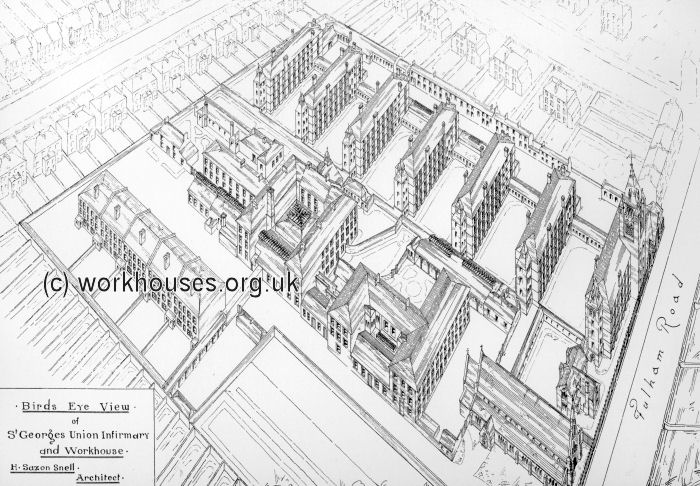 St George's Union, Fulham Road, 1878.
St George's Union, Fulham Road, 1878.© Peter Higginbotham.
A contemporary description gave details of the new buildings:
ENLARGEMENT OF THE
ST. GEORGE'S WORKHOUSE AT CHELSEA,
AND NEW CHAPEL AND INFIRMARY
BUILDINGS.
New buildings of a very extensive character have for some time been in course of erection at the Workhouse in Fulham-road, Chelsea, jointly for the St. George's (Hanover-square) Union, and the parishes of St. James and St. Margaret, Westminster. The works include an enlargement of the workhouse, together with the erection of an entirely new chapel of large dimensions; and likewise extensive new infirmary buildings in separate blocks, covering a ground area of about two acres and a half in extent. The estimated cost of the several buildings, when completed, is about 110,000l.
The enlargement of the workhouse, which is now almost finished, consists of additional men and women's receiving wards; an extension of the male and female infirmary wards, carried up two stories above the ground-floor; a new block on the east side containing additional able-bodied wards, to accommodate 400 inmates, and which is 246 ft. long by 74 ft. wide, including a dining-hall one story in height, the main building containing two stories above the ground floor. The dining-room runs the entire length of the main building, and is 15 ft. in width. The extensions further include new administrative offices, a new master's house, additions to the married inmates' department, to accommodate ten additional couples, together with a new engine-house.
On the open area in front of the workhouse buildings, with its principal elevation at the south side of Fulham-road, a new chapel, Early English in style, hag been erected, to seat a congregation of a little more than 600. It is about 120 ft. in length, and 50 ft. in width. The Fulham-road frontage terminates with a gable, surmounted by a bell-turret and vane. In addition to lofty three-light windows at each end, and similar side-aisle windows, the nave is further lighted by clearstory windows. The principal entrance is at the Fulham-road frontage, with two other entrances on the east and west sides. The nave is 95 ft. in length to the chancel steps, and the chancel itself 15 ft. in length, making the entire length of the interior, 110 ft. Five arches on either side divide the nave from the aisles. The circular arcade columns are in Dumfries stone, with red brick arches. The external as well as the internal walls are in stock brick, with red brick bands. The floor levels of the chancel and table are raised considerably above that of the nave, from which they are approached by a flight of five steps. The organ-chamber is on the east side, and the vestry on the west side, of the chancel; and at the north end, over the Fulham-road entrance, there is a gallery 15 ft. in depth. The whole of the carpenter and joiner's work in the interior, including the open ceiling, and the benches, pulpit, and other fittings, is in stained pitch-pine.
The new infirmary in course of erection is situated on a piece of ground immediately adjoining the workhouse buildings, and which, as already stated, is two acres and a half in extent. It is on the pavilion plan, and will consist of seven blocks. The Fulham-road frontage is 160 ft. in length, the several blocks being carried to a depth southwards of 600 ft. The Fulham-road elevation has a tower and turret with vane, carried to a height of 140 ft.; and at the east and west angles of the tower there are pinnacles. At the top of the tower there will be a large cistern, with a capacity to contain several thousand gallons of water. There are two entrances from the Fulham-road frontage, — one to the blocks containing the patients' wards, and the other to the administrative department, a separate block on the extreme west side. The several blocks containing the wards consist of three stories in addition to the ground-floor, and are 60 ft. in height to the eaves. Each floor is 84 ft. in length from east to west, and 24 ft. wide; and, in addition to the wards, there are nurses' rooms, lavatories, and other conveniences, to every floor. The airing and recreation space facing the west, between the different blocks, is 60 ft. in width. The wards are approached by a corridor on the west side, running the entire length of the buildings. The administrative block contains the general offices, kitchens, stores, nurses' apartments, committee-rooms, and dispensary, and close adjoining are the washhouses and steam laundry. A new residence for the house-surgeon to the infirmary, having a covered communication with it, has been erected at the Fulham-road frontage; and a corridor on the east side of the infirmary, 80 ft. in length and 6 ft. in width, connects it with the new chapel.
The architect is Mr. H. Saxon Snell; and the contractors are Messrs. Wall Brothers. The works are being carried out under the suprintendence of Mr. Walter E. Blake; and Mr. E. Thompson is clerk of works.
Other architect's drawings shows the impressive Fulham Road frontage:
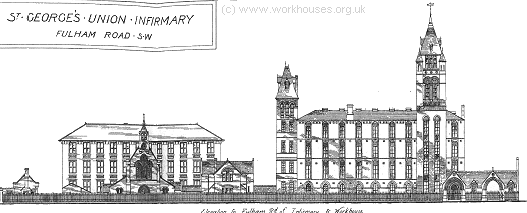
St George's Union, Fulham Road, 1878.
© Peter Higginbotham.
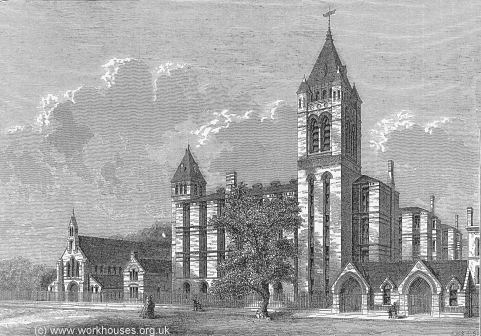
St George's Union Infirmary entrance from the west, early 1900s.
© Peter Higginbotham.
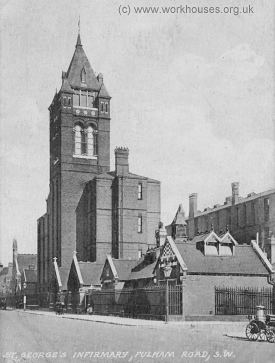
St George's Union Infirmary entrance from the west, early 1900s.
© Peter Higginbotham.
The site layout in 1913 is shown on the map below.
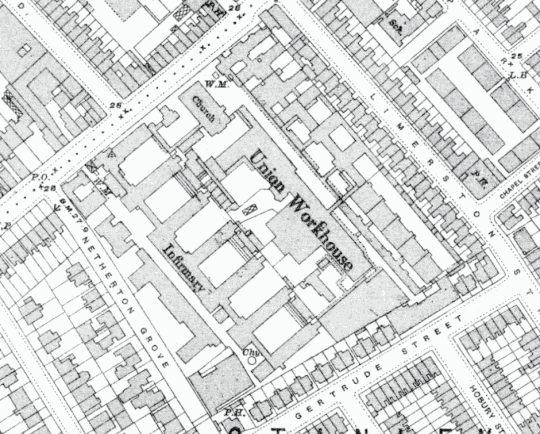
St George's Union workhouse, Fulham Road site, 1913.
The picture below shows the view from just inside the Fulham Road entrance ('W.M.' on map above). The tall building at the left of centre is the Roman Catholic inmates' chapel.
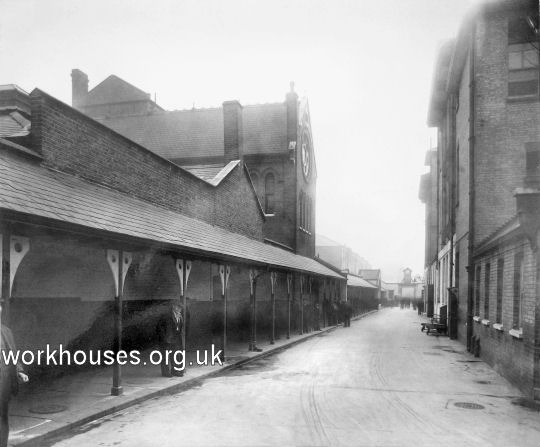
St George's workhouse from Fulham Road.
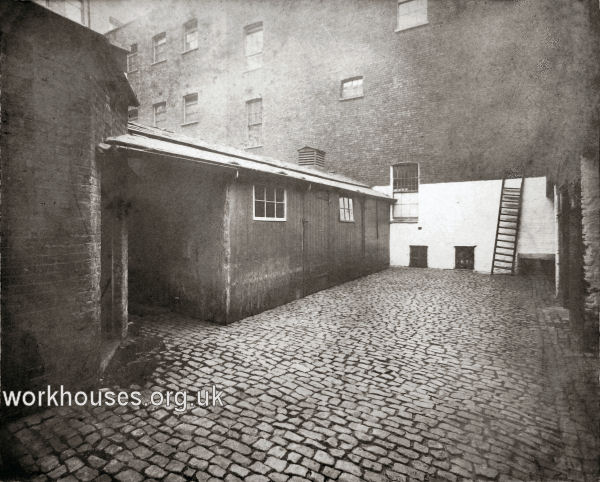
St George in the East, workhouse yard, 1890s.
Following the extension of the Fulham Road premises, the Mount Street and Wright's Lane workhouses were closed.
A nurses' home was erected on the Fulham Road site in 1899, and later additions included isolation blocks and a mortuary.
In 1880, St George's had one of its most unusual inmates — an African Zulu.
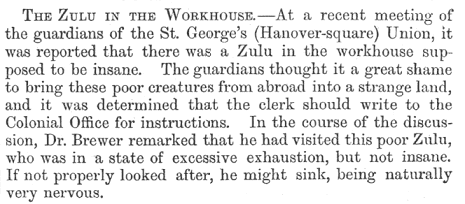
St George's Zulu inmate.
In 1894, the British Medical Journal set up a "commission" to investigate conditions in provincial workhouses and their infirmaries. Following a visit to the Fulham Road site (still referred to by its earlier designation as the St George Hanover Square workhouse), the commission's report made fairly unhappy reading. The wards, especially the dormitories, were crowded. The old and infirm, 60 in the male wards and 153 in the female, were looked after by just two nurses assisted by paupers. The report suggested that the pauper assistants took advantage of those in their care and were liable to "levy contributions from the helpless before rendering service." In the dormitories, cleaners were observed trying to "eradicate the vermin by burning out the nests and eggs in the interstices of the bedsteads." The inmates, it was noted, often preferred to use their chamber pots in preference to the wash-basins for washing themselves. The ancient laundry was "small and ill-found". Although more than 16,000 items were washed each week, "the mangles are turned by hand, the washing machine is small, there is only one wringer, the drying closets are small, there is no callender, indeed no machinery to speak of." Further details are available in the full report.
After 1930, the Fulham Road workhouse and hospital came under the control of the London County Council and the site was renamed St Stephen's Hospital. A completely new hospital now occupies the site.
The Wallis's Yard Workhouse
Not long after the formation of the St George's Union's, the old Mount Street workhouse site's lease was coming to an end. The Duke of Westminster, the land's owner, was initially inclined to renew the lease, but eventually changed his mind. Instead, he offered an alternative site at Wallis's Yard (now Warwick Row) off Buckingham Palace Road where a new "Receiving House" and casual ward were built in 1883-4 to a design by Henry Saxon Snell. The building's location is shown on the 1888 map below.
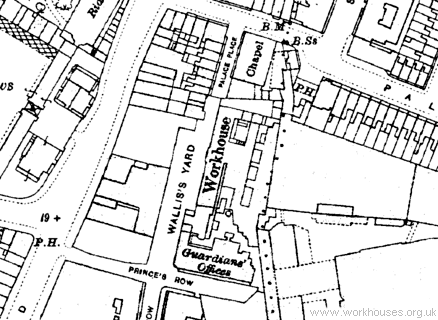
St George's Union, Wallis's Yard site, 1916.
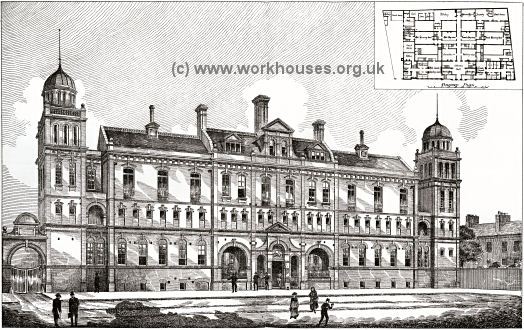
St George's Wallis's Yard workhouse frontage, 1884.
© Peter Higginbotham.
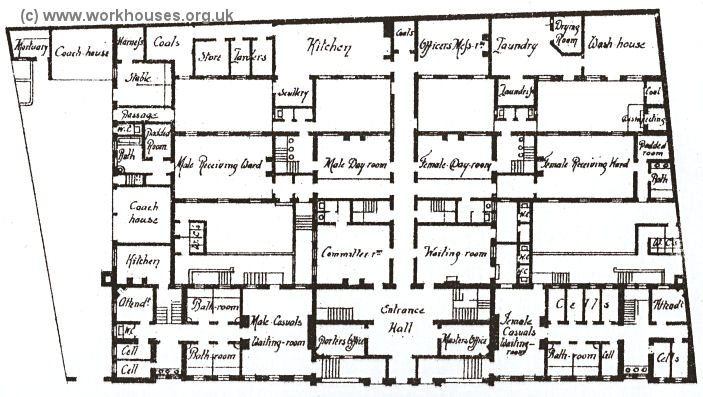
St George's Wallis's Yard workhouse ground-floor plan, 1884.
© Peter Higginbotham.
The ground and first floor of the front building was used for the reception of up to sixty casuals, each of whom was accommodated with a separate apartment or cell. The third floor wass fitted up as sick wards for twelve patients of each sex. The central portion of the ground-floor of the front block contained the entrance-hall, with master's and porter's office, and, adjoining it, a committee-room and waiting-room for applicants for out-door relief. The buildings in the central block contained accommodation for fourteen paupers of each sex, and there were two padded rooms for dangerous lunatics. A small number of paupers were kept at the buildings and employed in performing cleaning and similar duties. The buildings at the rear consisted of a kitchen, with larders and stores, a laundry, disinfecting closet, and other offices. Stabling, with large ambulance accommodation, was provided at one end of the site left of the entrance. The contract for the erection of the buildings, including engineering work and all fittings, amounted to £20,900.
The Wallis's Yard workhouse continued in operation until 1921 and the buildings no longer exist. The Mount Street premises were demolished in 1886 as part of a major redevelopment of the area.
Millman Street Children's Home
Until 1914, St George's operated a children's home at Milman's Street, Chelsea.
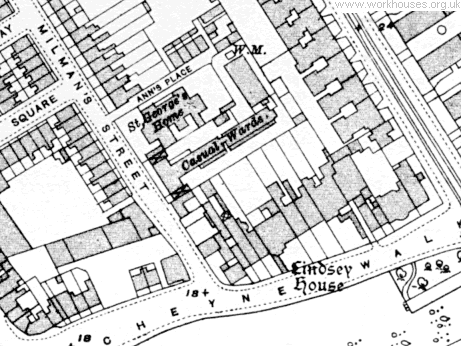
St George's Home site, 1916.
Staff
Inmates
Records
Note: many repositories impose a closure period of up to 100 years for records identifying individuals. Before travelling a long distance, always check that the records you want to consult will be available.
-
City of Westminster Archives Centre, 10 St Ann's Street, London SW1P 2DE.
Holds only pre-1870 parish records except for:
- Fulham Road Workhouse: baptism registers (June 1879 - August 1900)
- Wallis's Yard Workhouse: baptism registers (January 1866 - December 1892)
-
The
Ancestry UK
website has two collections of London workhouse records (both name searchable):
- Westminster workhouse records are available on FindMyPast, .
-
London Metropolitan Archives, 40 Northampton Road, London EC1R OHB.
- Mount Street workhouse holdings include: Creed registers (1874-84); Register of children boarded-out (1871-1913).
- Wallis's Yard workhouse holdings include: Births (1885-97); Deaths (1885-1918); Creed registers (1884-93, 1910-21)
- Fulham Road workhouse holdings include: Admissions and discharges (1866-1916); Births (1879-89); Baptisms (1900-07); Deaths (1870-1932); Master's journal: (1903-13); etc.
- Fulham Road infirmary holdings include: Baptisms (1878-86); etc.
- Other holdings include: Guardians' minute books (1870-1915); Financial records (1870-1921, with gaps); Staff records (1863-1914); etc.
Bibliography
- Higginbotham, Peter Workhouses of London and the South East (2019)
Links
Unless otherwise indicated, this page () is copyright Peter Higginbotham. Contents may not be reproduced without permission.


